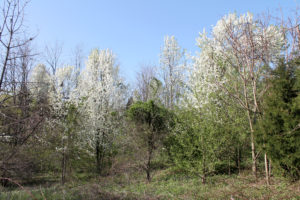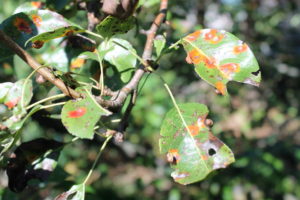Good Tree Goes Rogue
September 16th, 2020
This is a classic tale of a good guy turned bad… except the star is a tree instead of a movie villain.
It’s about the ornamental or “callery” pear, that hard-to-kill spring beauty that blooms white in yards, parking lots, and along streets all over Pennsylvania and beyond.
When it came to market in the 1950s as a cultivar named ‘Bradford,’ the tree sounded like a wunderplant.
It bloomed profusely in spring, then turned an equally stunning glossy blood-red in fall.
It grew in lousy soil, grew fast, hardly ever ran into bugs or disease, and didn’t produce fruits that would make patios, streets, and sidewalks “messy.”
No wonder people planted them everywhere.
Then by the 1970s, the first chink in this tree’s armor started appearing.
It turned out that as ‘Bradfords’ aged, their wood became brittle. Trees were soon notorious for cracking apart in storms.
Read George’s article on “Muscle Trees” that are strongest in storms
No problem. Breeders got to work developing new cultivars that were stronger-limbed alternatives with the same prolific spring blooms, brilliant fall foliage, and can’t-kill-me attitude.
Cultivars such as ‘Aristocrat,’ ‘Cleveland Select’ (a.k.a. Chanticleer), and ‘Redspire’ became the new choices in the growing callery pear family. (The species, Pyrus calleryana, was named after the French missionary Joseph Callery, who discovered it in Asia in 1858.)
Unfortunately, that was only the beginning of this roguish story.
While the original ‘Bradford’ pear couldn’t self-pollinate to produce fruits, it did cross-pollinate with the new cultivars.
By the turn of this century, people were beginning to complain about their once and supposedly fruitless ornamental pear trees suddenly producing gobs of small pears about the size of a pinky-fingertip.
Next thing we knew, birds were eating the fruits and pooping out the seeds everywhere. In untended open areas, pear trees suddenly started popping up.
That’s when the tree’s survivor nature turned from benefit to liability. Thickets of wild seedlings have been thriving and spreading, creating virtual plantation fields of nothing but wild callery pears.
Environmentalists and land managers were alarmed enough that the whole callery-pear species was added to Pennsylvania’s Invasive Plant List.
Callery pears soon became the poster child of invasive plant species.
The general public, on the other hand, hasn’t paid as much attention. If they notice these fields of white in spring, people are more apt to wonder what all of those “pretty white trees” are and look into buying one for their own yard.
Check out these wild pears up close, though, and you’ll see they’ve taken on another not-so-nice characteristic – thorns. They’re not little wiry things either. They’re stiff, sharp, little woody swords that easily draw blood if you get too close.
As if that’s not enough, callery pears added one more rogue trait that was newly obvious this season. If you noticed your car or patio turned a mysterious powdery orange near a pear tree in June, you experienced rust – one of the stranger diseases in the plant world.
Rust is a foliar disease that jumps back and forth between two different plant genera. It needs both types of plants to survive.
In this case, it’s cedar-quince rust – a version that uses juniper as the one host (especially the native eastern red cedar) and a rose-family tree or shrub as the other (quince, apple, hawthorn, pear, etc.)
On junipers, the disease causes orange blobs that look like something alien Jell-O-eaters might have drooled overnight.
On a tree like pear, it matures into spores that spew a powdery orange dust over whatever happens to be beneath.
Cedar-quince rust is especially fond of colonizing pear fruits. Since our landscape callery pears are now prolific fruit producers, they’ve become super repositories for rust-spore growth.
From what I’ve been able to discern, homeowners as a whole are pretty oblivious to and/or unconcerned about pears invading the wild, but they don’t take kindly to trees that turn their patio umbrellas orange or that drop messy fruits on the deck.
Maybe that will be the final straw that finally convinces us to plant something other than a callery pear.
See George’s list of Top 10 Small Trees










